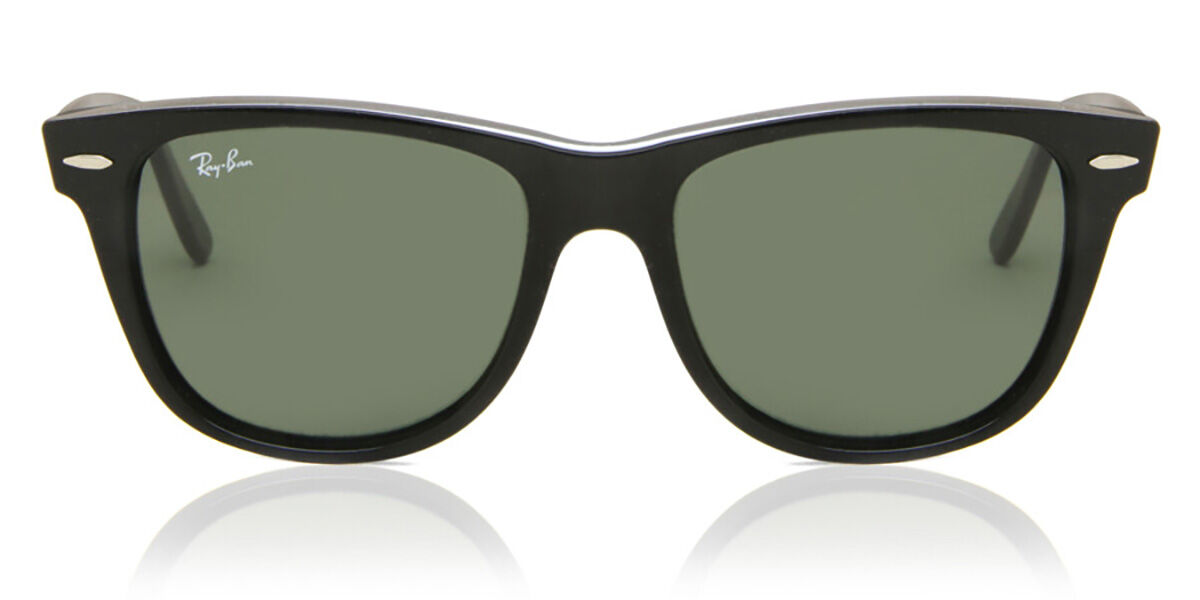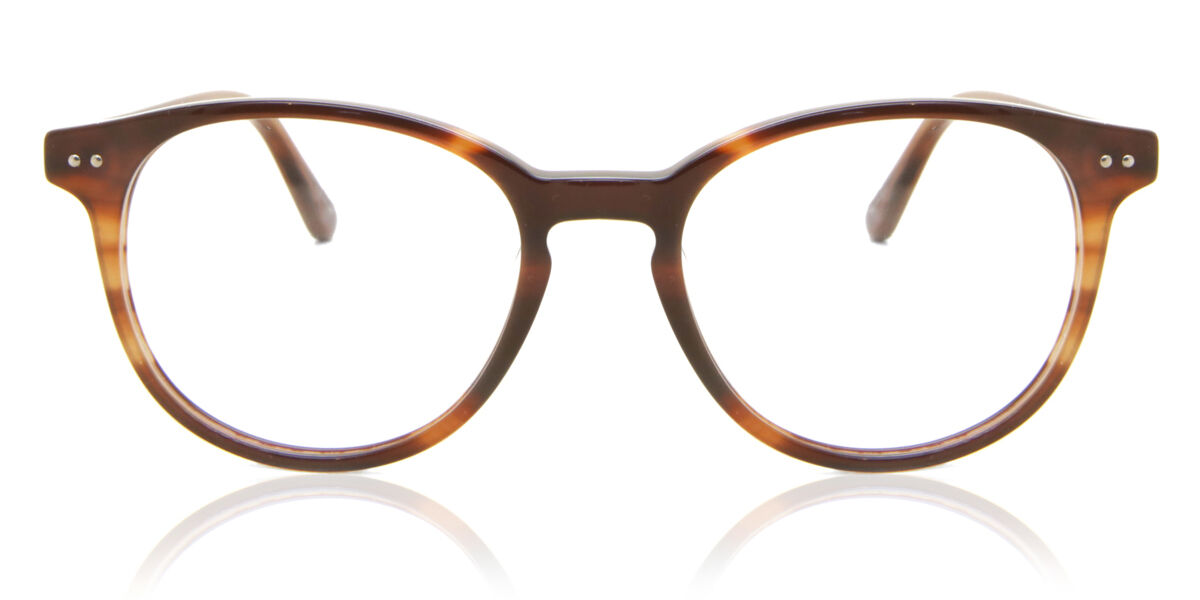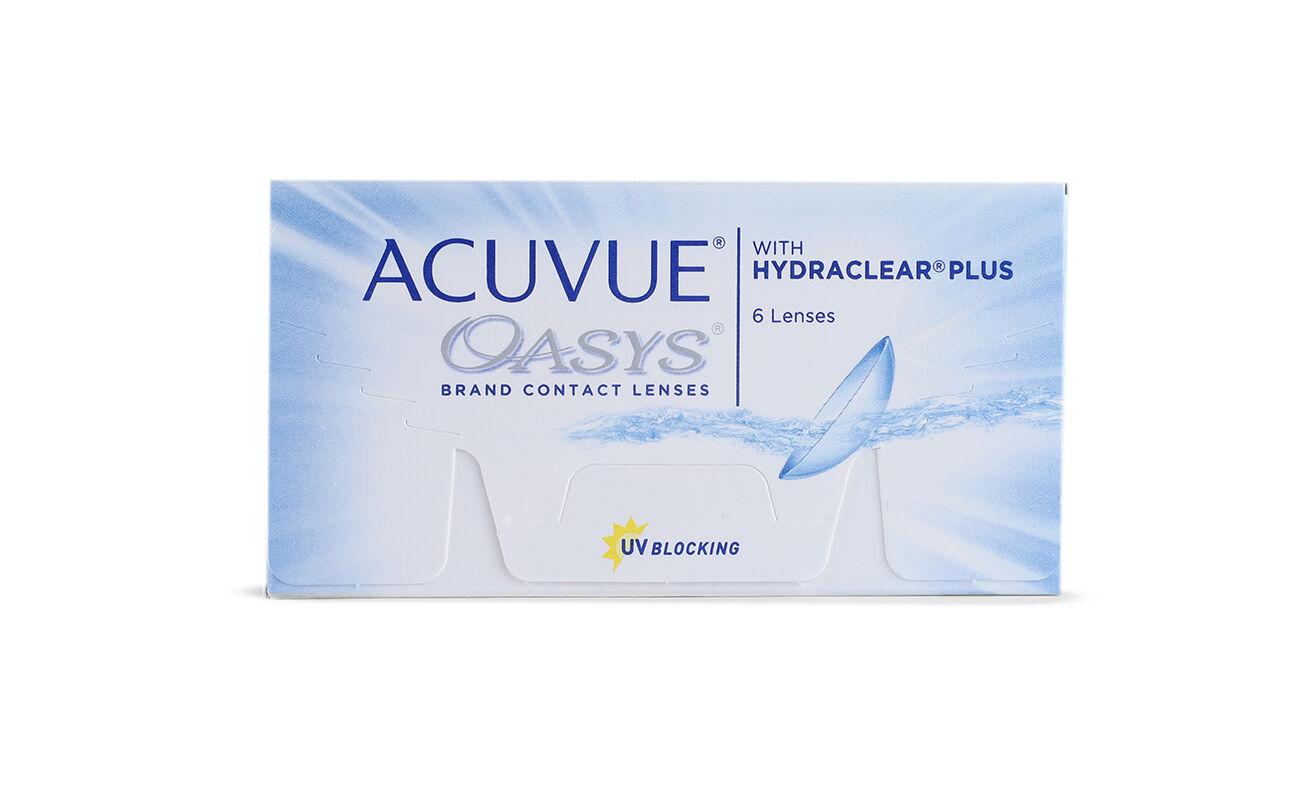Lowest Prescription for Contacts
Is a glasses prescription the same? | How to read your prescription | Numbers in the prescription | How long does it last? | How low does it go? | Strongest prescription | Advantages

Reviewed by
Beck Jinette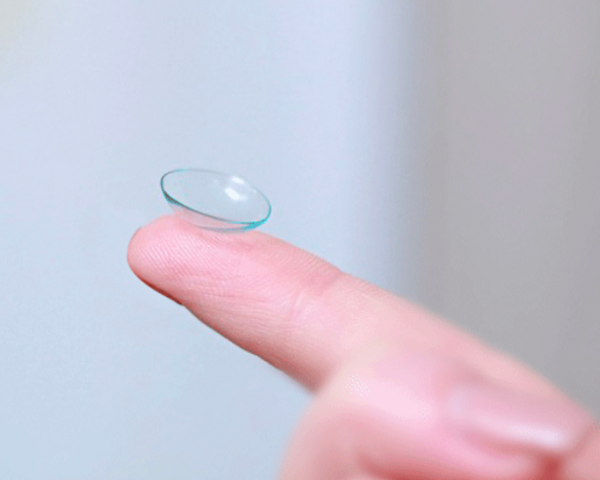
Contact lenses have become much more comfortable, breathable and versatile since they were first designed in the 19th century. The earliest versions were blown from glass, so it’s no wonder they were less popular than they are now. Today, contact lenses are thin, plastic lenses used for vision correction. Contact lenses differ from glasses as they are worn directly on the cornea, the front surface of the eye. Contact lenses adhere to the shape of the eye, allowing a wider field of vision and fewer distortions or obstacles than prescription glasses.
Contact lenses have become much more comfortable, breathable and versatile since they were first designed in the 19th century. The earliest versions were blown from glass, so it’s no wonder they were less popular than they are now. Today, contact lenses are thin, plastic lenses used for vision correction.
Contact lenses differ from glasses as they are worn directly on the cornea, the front surface of the eye. Contact lenses adhere to the shape of the eye, allowing a wider field of vision and fewer distortions or obstacles than prescription glasses.
Are glasses prescriptions and contact lens prescriptions the same?
The lens power in glasses and contact lenses can correct nearsightedness, farsightedness, or astigmatism. Just as contact lenses and glasses are not worn in the same way, their prescriptions also differ. Glasses generally rest about 12 mm from the eyes, whereas contacts are worn directly on the eyes and have a much smaller surface area. The distance from the eye directly impacts the difference in lens power.
A prescription for eyeglasses and contact lenses will require separate eye exams and measurements from your optometrist as the prescriptions will differ. Additionally, with so many types of contact lenses available it is important a correct fit and brand is prescribed. Ordering contact lenses with the wrong prescription can lead to symptoms such as blurry vision, headaches, eye strain or fatigue and eye pain (AAO, 2012).
The lens power in glasses and contact lenses can correct nearsightedness, farsightedness, or astigmatism. Just as contact lenses and glasses are not worn in the same way, their prescriptions also differ.
Glasses generally rest about 12 mm from the eyes, whereas contacts are worn directly on the eyes and have a much smaller surface area. The distance from the eye directly impacts the difference in lens power.
A prescription for eyeglasses and contact lenses will require separate eye exams and measurements from your optometrist as the prescriptions will differ. Additionally, with so many types of contact lenses available it is important a correct fit and brand is prescribed.
Ordering contact lenses with the wrong prescription can lead to symptoms such as blurry vision, headaches, eye strain or fatigue and eye pain (AAO, 2012).
How to read a contact prescription
If you’ve received an eye exam, got your new prescription and are ready to buy contact lenses online but need clarification, you’re not alone! Codes like “D, CYL and AXIS” are all over your prescription, but what do they mean?
Many people need different levels of vision correction in each eye, so a contact lens prescription may have two sets of numbers—one for your right eye and one for your left eye. OD, oculus dexter, refers to your right eye, while OS, oculus sinister, refers to your left eye.
- Base Curve (BC) determines the type of fit required for the lens to meet the curve of your eye. It is measured in millimeters (mm) and aligns with the curvature of your eye.
- Power (PWR)/Sphere (SPH) refers to the strength of your prescription. You will see a plus sign (+) or a minus sign (-) followed by a number. If you are farsighted, your figure will begin with a plus sign. If you are nearsighted, it will start with a minus sign.
- Diameter (DIA) is the entire width of your contact lenses. Also measured in millimeters, the higher the base curve, the flatter the cornea’s curvature.
If you need astigmatism correction, you will have two additional terms and numbers on the prescription. For those with astigmatism, you will need toric lenses.
- Cylinder (CYL) represents the severity of your astigmatism and the additional visual requirements needed for vision correction.
- Axis (AX) is measured in degrees and tells you where and how your astigmatism is located and oriented on your eye.
For those with presbyopia or who need multifocal lenses, you will notice one or both of the following on your prescription.
- Addition (ADD) determines the amount of correction you need to be able to see clearly at a close distance.
- Dominant (D/N) identifies your dominant (D) and non-dominant (N) eye. The dominant eye usually prioritises distance vision, while the non-dominant eye prioritises near vision.
Your prescription will also include a brand of contact lenses. Contact lens boxes will include most of the prescription details on them as well. Different contact lens brands have distinct features and measurements, so it is important only to order the brand prescribed. If you want or need to switch brands, it is essential to let your eye doctor know.
If you’ve received an eye exam, got your new prescription and are ready to buy contact lenses online but need clarification, you’re not alone! Codes like “D, CYL and AXIS” are all over your prescription, but what do they mean?
Many people need different levels of vision correction in each eye, so a contact lens prescription may have two sets of numbers—one for your right eye and one for your left eye. OD, oculus dexter, refers to your right eye, while OS, oculus sinister, refers to your left eye.
- Base Curve (BC) determines the type of fit required for the lens to meet the curve of your eye. It is measured in millimeters (mm) and aligns with the curvature of your eye.
- Power (PWR)/Sphere (SPH) refers to the strength of your prescription. You will see a plus sign (+) or a minus sign (-) followed by a number. If you are farsighted, your figure will begin with a plus sign. If you are nearsighted, it will start with a minus sign.
- Diameter (DIA) is the entire width of your contact lenses. Also measured in millimeters, the higher the base curve, the flatter the cornea’s curvature.
If you need astigmatism correction, you will have two additional terms and numbers on the prescription. For those with astigmatism, you will need toric lenses.
- Cylinder (CYL) represents the severity of your astigmatism and the additional visual requirements needed for vision correction.
- Axis (AX) is measured in degrees and tells you where and how your astigmatism is located and oriented on your eye.
For those with presbyopia or who need multifocal lenses, you will notice one or both of the following on your prescription.
- Addition (ADD) determines the amount of correction you need to be able to see clearly at a close distance.
- Dominant (D/N) identifies your dominant (D) and non-dominant (N) eye. The dominant eye usually prioritises distance vision, while the non-dominant eye prioritises near vision.
Your prescription will also include a brand of contact lenses. Contact lens boxes will include most of the prescription details on them as well. Different contact lens brands have distinct features and measurements, so it is important only to order the brand prescribed. If you want or need to switch brands, it is essential to let your eye doctor know.
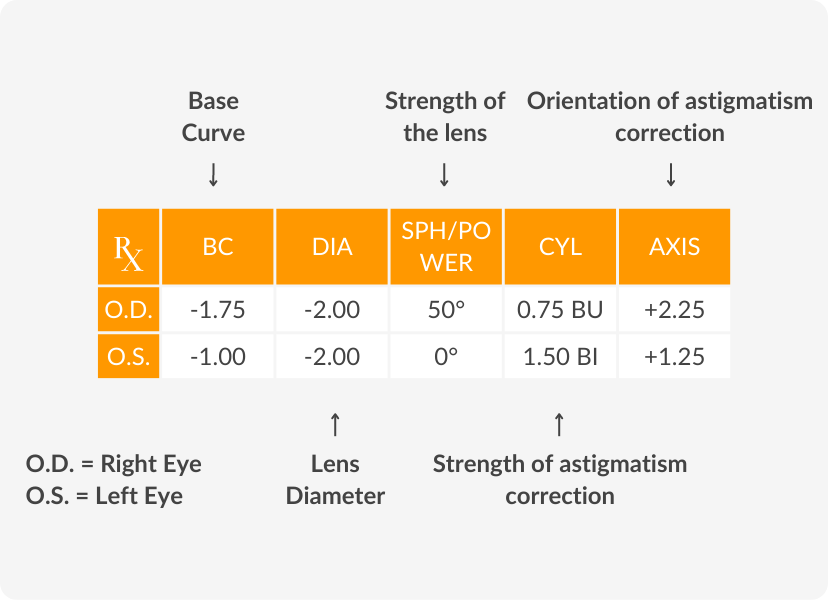
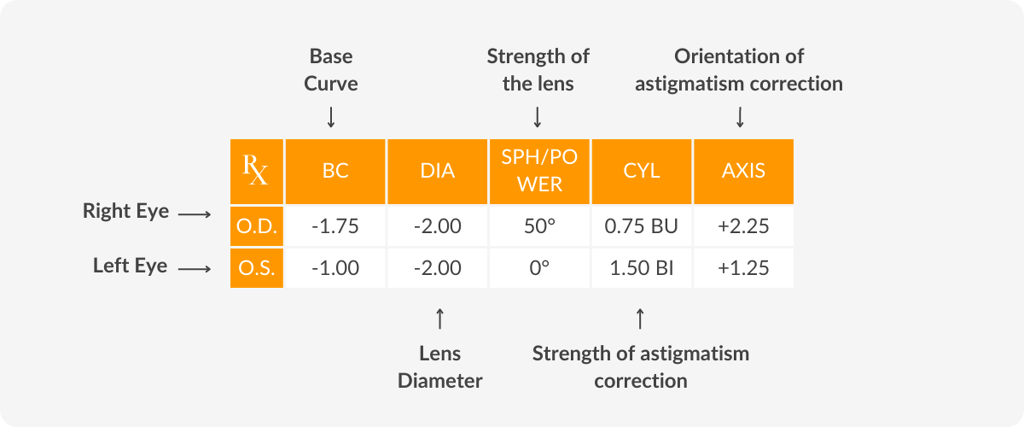
DID YOU KNOW?
What do the numbers mean in a contact prescription?
If you understand what the codes mean, you may still wonder what the numbers mean. BC and DIA will not be present on your glasses prescription, as they refer only to a contact lens prescription. Measured in millimetres, the BC is always a number between 8 and 9 and will align with the curvature of your eye. DIA is typically between 14 and 14.5 millimetres and determines the entire width of your contact lens.
The PWR or SPH (prescription strength) is measured in increments of 0.25 diopters. The further from zero, the stronger the vision correction needed. A negative number, -1.00, indicates nearsightedness. A positive number, for example, +2.00, indicates farsightedness.
CYL is always a negative number measured in increments of 0.25, showing the amount of astigmatism. AX is a number between 0 and 180 degrees, referring to the angle of correction needed. For those with presbyopia, the ADD figure is a positive number between 0.50 and 3.00.
If you still need help reading and understanding your contact lens prescription, contact your optometrist or head to our Optical Centre to speak with one of our opticians.
If you understand what the codes mean, you may still wonder what the numbers mean. BC and DIA will not be present on your glasses prescription, as they refer only to a contact lens prescription.
Measured in millimetres, the BC is always a number between 8 and 9 and will align with the curvature of your eye. DIA is typically between 14 and 14.5 millimetres and determines the entire width of your contact lens.
The PWR or SPH (prescription strength) is measured in increments of 0.25 diopters. The further from zero, the stronger the vision correction needed. A negative number, -1.00, indicates nearsightedness. A positive number, for example, +2.00, indicates farsightedness.
CYL is always a negative number measured in increments of 0.25, showing the amount of astigmatism. AX is a number between 0 and 180 degrees, referring to the angle of correction needed. For those with presbyopia, the ADD figure is a positive number between 0.50 and 3.00.
If you still need help reading and understanding your contact lens prescription, contact your optometrist or head to our Optical Centre to speak with one of our opticians.
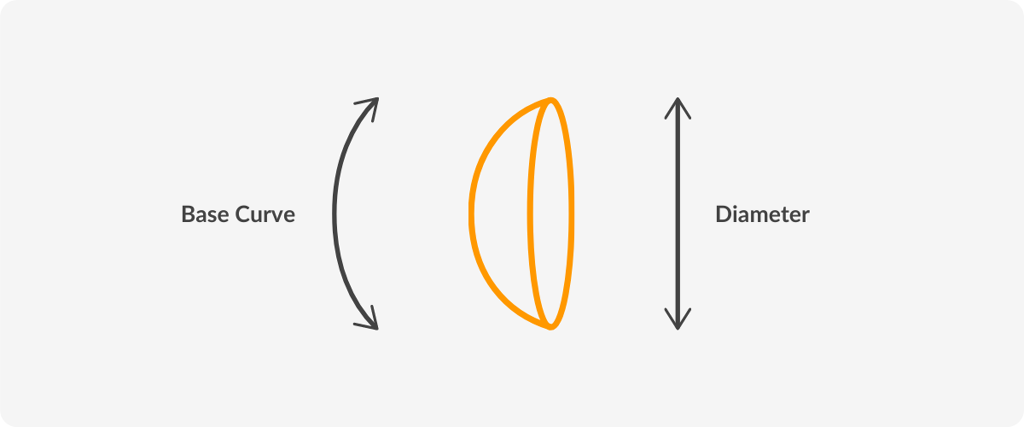
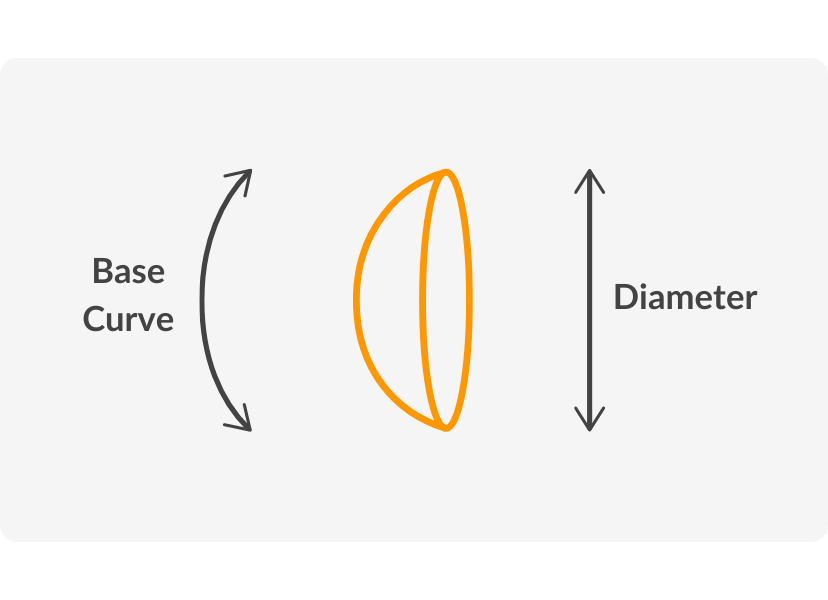
How long is a contact prescription good for?
Most contact lens prescriptions expire within one to two years of your last eye exam. Once your prescription has expired, it is important to see your eye doctor for a new contact lens prescription. Wearing the wrong prescription contacts may create discomfort and lead to further vision problems.
How low do contact prescriptions go?
Contact lenses are becoming more and more diverse and available for those in need of vision correction. Contact lenses are now offered at the lowest prescription of -0.25/+0.25. Many people neglect to wear their low-prescription eyeglasses because of inconvenience, but wearing low-prescription contacts might be a good solution as they can be considered less obstructive.
Contact lenses don’t interfere with equipment such as helmets, hats, or goggles. During sports or exercise, contact lenses don’t get in the way. They’re not at risk of falling off or breaking. Contact lenses are not usually affected by weather as they don’t fog up in the cold.
Correcting your vision and protecting your eyes at any prescription level is important. If you’re avoiding your glasses for ease and convenience, speak with your eye doctor about receiving an eye exam and switching to contact lenses.
What is the strongest contact lens prescription?
Advances in contact lens technology have made it so that contact lenses can be worn safely and comfortably by those with high-power prescriptions. Standard contact lenses are readily available in prescriptions from -12.00 to +8.00, and cylinder powers up to -2.25 or -2.75 for astigmatism correction. Extended-range lenses are also available with spherical powers of +15.00D to –20.00D and up to –5.75D in cylindrical powers (Contact Lens Spectrum, 2016).
Soft contact lenses with high powers have thicker edges compared to low-powered ones. These thicker edges may be less comfortable to wear and cause more dry eyes. Many people with high-power prescriptions choose RGP lenses (rigid gas permeable or ‘hard’) as they are smaller and thinner than a soft lens. RGP lenses don’t bend like soft lenses, but they let oxygen through so your eyes can breathe.
Advances in contact lens technology have made it so that contact lenses can be worn safely and comfortably by those with high-power prescriptions.
Standard contact lenses are readily available in prescriptions from -12.00 to +8.00, and cylinder powers up to -2.25 or -2.75 for astigmatism correction. Extended-range lenses are also available with spherical powers of +15.00D to –20.00D and up to –5.75D in cylindrical powers (Contact Lens Spectrum, 2016).
Soft contact lenses with high powers have thicker edges compared to low-powered ones. These thicker edges may be less comfortable to wear and cause more dry eyes. Many people with high-power prescriptions choose RGP lenses (rigid gas permeable or ‘hard’) as they are smaller and thinner than a soft lens. RGP lenses don’t bend like soft lenses, but they let oxygen through so your eyes can breathe.
Advantages of contact lenses
While contact lenses might not be for everyone, many contact lens wearers won’t go back to standard eyeglasses. Contacts conform to your eye, reducing distortion and obstructions. They won’t stop you from playing sports or competing in outdoor activities. Contact lenses are also available in coloured lenses, so you can experiment with your eye colour.
With varying contact lens power, affordable contact lenses and varying lens materials, there are contact lenses for everyone. Based on your lifestyle, you can speak with your eye doctor about purchasing daily disposable lenses, weekly or monthly lenses.
Contact lenses prescription
Buying contact lenses doesn’t have to be confusing. They’re an excellent alternative for those looking to ditch their eyeglasses. It is important to remember that glasses and contact lens prescriptions are different. Do not assume that any numbers on your glasses prescription will match your contact lens prescription. If you want to try contact lenses, schedule an eye exam to determine what you need and what lens type will best suit you.
For people with vision problems, contacts are an effective, almost invisible tool. The thin lenses correct vision problems including nearsightedness, farsightedness and astigmatism. You can even wear contacts if you have presbyopia and need bifocals. As technology and medicine continue to advance, contact lenses are only improving. Speak with your eye doctor about getting a prescription for contact lenses and start seeing clearer and more comfortably.
Buying contact lenses doesn’t have to be confusing. They’re an excellent alternative for those looking to ditch their eyeglasses. It is important to remember that glasses and contact lens prescriptions are different.
Do not assume that any numbers on your glasses prescription will match your contact lens prescription. If you want to try contact lenses, schedule an eye exam to determine what you need and what lens type will best suit you.
For people with vision problems, contacts are an effective, almost invisible tool. The thin lenses correct vision problems including nearsightedness, farsightedness and astigmatism. You can even wear contacts if you have presbyopia and need bifocals.
As technology and medicine continue to advance, contact lenses are only improving. Speak with your eye doctor about getting a prescription for contact lenses and start seeing clearer and more comfortably.
REFERENCES
- American Academy of Ophthalmology. (2012). Can outdated contact lenses harm your eyes? [Online]. Available at: https://www.aao.org/eye-health/ask-ophthalmologist-q/wearing-outdated-contacts
- Contact Lens Spectrum. (2016). Specialty and Custom Soft Contact Lenses. [Online]. Available at: https://www.clspectrum.com/issues/2016/december-2016/specialty-and-custom-soft-contact-lenses





































